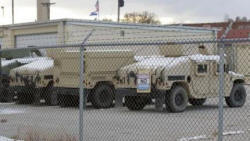|
 As
Missouri awaits decision on police shooting, National Guard called in As
Missouri awaits decision on police shooting, National Guard called in
 Send a link to a friend
Send a link to a friend
[November 18, 2014]
By Scott Malone
FERGUSON Mo. (Reuters) - Troops from the
Missouri National Guard were due to deploy on Tuesday around Ferguson,
Missouri, as the city awaits a grand jury's decision on whether to
indict a white police officer who shot and killed an unarmed black teen
in August.
|
|
 Governor Jay Nixon has declared a state of emergency in Missouri
but local officials said troops would play a backup role to police
in responding to any protests that develop after the grand jury's
report. Governor Jay Nixon has declared a state of emergency in Missouri
but local officials said troops would play a backup role to police
in responding to any protests that develop after the grand jury's
report.
People around St. Louis are braced for a possible reprise of the
wave of sometimes violent protests that followed the Aug. 9 fatal
shooting of 18-year-old Michael Brown, particularly if Ferguson
police officer Darren Wilson is not charged.
Officials have said the grand jury's decision is likely to come this
month.
"The National Guard is well suited to provide security at command
posts, fire stations and other locations, freeing up law enforcement
officers to focus on community policing and allowing citizens to
exercise their constitutional rights," Nixon told reporters.
He declined to say how many National Guard troops would be assigned
to the St. Louis area or where they would be stationed.
 In the past two days, peaceful demonstrations were held around St.
Louis and some local leaders expressed frustration that Nixon had
pre-emptively declared a state of emergency.
"The National Guard is called in when policing has failed. Military
presence in my city will mark a historic failure on the part of
(government)," Antonio French, a St. Louis alderman, said on
Twitter. "This is not a war. There is no military solution."
Police in Ferguson were criticized for taking a military posture in
response to the August demonstrations, regularly deploying officers
in riot gear and using tear gas and rubber bullets against crowds
that torched two businesses in the St. Louis suburb and at times
threw rocks and gasoline bombs at police.
[to top of second column] |

Police in St. Louis County have since gone through conflict
de-escalation training and activist leaders have also been training
potential protesters in nonviolent techniques in recent days.
St. Louis Mayor Francis Slay said police in his city would respond
to demonstrations in their normal uniforms unless conditions became
violent and that National Guard troops would not play a primary role
in responding.
Some area schools have told parents they will dismiss students early
when the decision comes and many businesses near the stretch of
downtown that saw the worst rioting after Brown's killing have
boarded up their windows as a protective move.
There are conflicting accounts of what happened, with some witnesses
saying Brown had his hands up in surrender when he was shot and
others describing a physical altercation between Brown and Wilson.
(Additional reporting by David Bailey in Minneapolis; Editing by
Peter Cooney)
[© 2014 Thomson Reuters. All rights
reserved.] Copyright 2014 Reuters. All rights reserved. This material may not be published,
broadcast, rewritten or redistributed.
 |